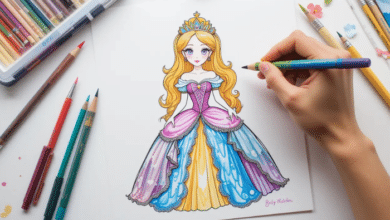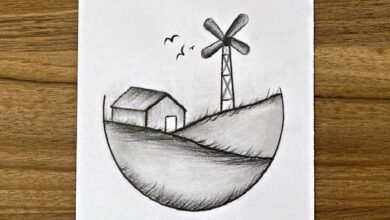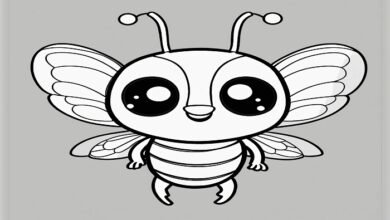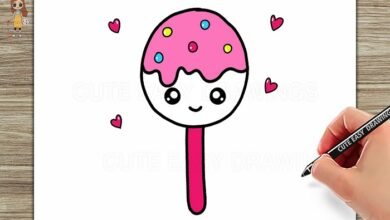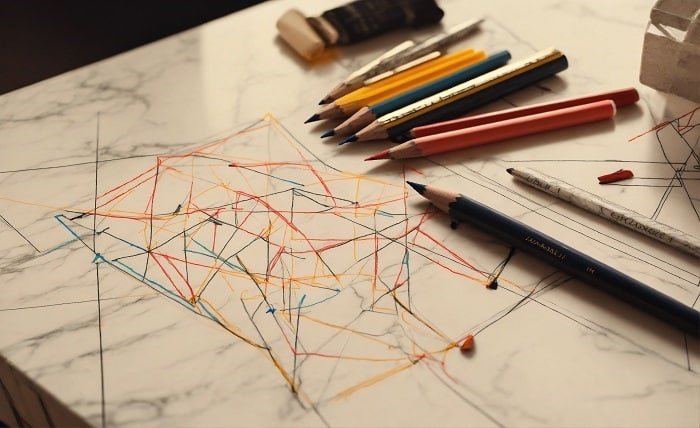
Easy drawing with pencil is a fantastic starting point for anyone interested in art. Pencil drawing allows beginners to experiment, explore, and refine their skills without the complexity of color or advanced tools. Drawing with pencil is both accessible and forgiving, making it perfect for learning the basics of line work, shading, and detail. It’s a medium that encourages creativity and exploration, as well as mastery of fundamental techniques.
Starting with easy drawing with pencil, you’ll gain confidence as you create simple sketches and progress to more detailed illustrations. The simplicity of pencil drawing enables you to focus on key aspects of drawing, such as shape, perspective, and shading, providing a strong foundation to build on.
Essential Tools for Easy Drawing with Pencil
When it comes to easy drawing with pencil selecting the right tools is crucial for achieving good results. While a simple pencil can get you started, having a small collection of pencils in various hardness grades will help you add depth and detail to your drawings. A standard set usually includes pencils labeled from H to B, with HB being in the middle, H pencils creating lighter lines, and B pencils creating darker, softer marks.
In addition to pencils, you’ll need a good-quality eraser and sketch paper. Erasers allow you to refine your work and adjust mistakes, while quality paper gives you a smoother surface for your drawings. These tools are affordable, making easy drawing with pencil an accessible hobby for beginners.
Basic Techniques for Easy Drawing with Pencil
Mastering basic techniques is key to creating impressive drawings. Easy drawing with pencil often begins with understanding and applying techniques such as hatching, cross-hatching, stippling, and blending. These methods add texture and depth to your drawings and give you greater control over shading and detail.
Hatching involves creating parallel lines to shade an area, while cross-hatching adds another layer of lines in a different direction. Stippling, or dotting, creates texture, and blending smooths out shading with tools like blending stumps or tissue paper. These techniques are fundamental to easy drawing with pencil, allowing you to create contrast and enhance the realism of your sketches.
Step-by-Step Guide to Easy Drawing with Pencil for Beginners
Learning easy drawing with pencil is easier when you follow a step-by-step guide. Start with simple shapes, such as circles, squares, and triangles, to practice creating even, clean lines. Once comfortable, try combining shapes to form basic objects like flowers, houses, or animals. As you gain confidence, add more details and experiment with shading.
Begin each drawing by lightly sketching the outline of your subject. Gradually refine the shapes and add details as you go. This approach ensures you capture the overall proportions and placement before diving into finer details. By breaking down your subject into simple steps, easy drawing with pencil becomes a manageable and enjoyable activity.
Shading and Depth in Easy Drawing with Pencil
Shading is an essential skill in easy drawing with pencil. It brings life to your sketches, creating the illusion of depth and making them more realistic. There are multiple shading techniques, including gradient shading, cross-hatching, and contour shading. Gradient shading, achieved by varying the pressure on your pencil, helps create smooth transitions from light to dark.
To practice shading, try drawing simple geometric shapes like spheres or cubes. Focus on where light would hit the object, and shade the opposite side. By learning how to add shadows and highlights, you’ll make your drawings appear more three-dimensional and dynamic. Shading is a powerful way to bring vibrancy to easy drawing with pencil, adding layers of complexity to even simple sketches.
Creating Textures in Easy Drawing with Pencil
Texture plays a significant role in making a drawing look realistic. Easy drawing with pencil includes techniques that allow you to replicate the textures of various materials, such as wood, metal, fur, or fabric. To achieve texture, experiment with different line styles, stroke directions, and pressure variations.
For instance, drawing short, quick lines can mimic the texture of fur, while long, smooth strokes can create the appearance of silk. Take time to observe the textures around you and try to recreate them in your sketches. Developing an eye for detail and understanding how to convey texture will elevate your easy drawing with pencil skills to a new level.
Common Mistakes in Easy Drawing with Pencil and How to Avoid Them
When starting with easy drawing with pencil, beginners often make certain common mistakes, such as pressing too hard, skipping warm-ups, or neglecting proportions. Pressing too hard can damage the paper and make erasing challenging. Instead, start with light strokes and build up to darker shades gradually.
Another common mistake is ignoring basic shapes and proportions. Spend time sketching the basic outline before adding details, ensuring that each element is proportionate. Practicing these foundational steps will prevent frustration and help you develop better habits in easy drawing with pencil.
Easy Drawing with Pencil for Realistic Portraits
Creating realistic portraits is an exciting challenge in easy drawing with pencil. Start by mastering facial proportions, such as the placement of eyes, nose, mouth, and ears. Practice drawing each feature separately before combining them to form a complete portrait. Drawing eyes, for instance, requires attention to detail in shading and highlights to make them appear lifelike.
When drawing portraits, use light, gradual strokes to build layers of shading, creating depth around facial features. Don’t rush the process; realistic portraits require patience and a steady hand. With practice, easy drawing with pencil can lead to impressive portrait drawings, showcasing both skill and creativity.
Exploring Different Styles in Easy Drawing with Pencil
Easy drawing with pencil doesn’t have to be limited to realism. Experimenting with different styles, such as cartoons, abstract art, and fantasy themes, adds variety to your drawing skills. Each style comes with unique characteristics and allows you to express your creativity differently.
Cartooning, for example, simplifies details and focuses on expressive lines and exaggerated features, making it accessible and fun for beginners. Abstract drawing allows freedom from precise shapes, encouraging creative expression. Exploring these different styles in easy drawing with pencil expands your versatility as an artist and gives you the freedom to discover what you enjoy most.
Conclusion
Easy drawing with pencil is a rewarding journey for anyone interested in art, from beginners to experienced artists. With the right techniques, tools, and a consistent practice routine, anyone can create stunning sketches with just a pencil and paper. Whether you’re drawing for relaxation, creativity, or improvement, the world of pencil drawing is filled with endless possibilities. Embrace each step, experiment with various techniques, and watch as your skills grow over time. With dedication and curiosity, easy drawing with pencil can transform your understanding of art and open up new creative avenues.
FAQs
Q1: What is the best pencil for easy drawing with pencil?
A: A variety of pencils, including HB, 2B, and 4B, are ideal for different shading and detailing in easy drawing with pencil.
Q2: How can I improve my shading in easy drawing with pencil?
A: Practice using light to dark gradients, hatching, and blending techniques to add realistic shading to your pencil drawings.
Q3: Can I create realistic drawings with easy drawing with pencil?
A: Yes, with practice in shading, proportions, and texture, realistic drawings are achievable using simple pencil techniques.
Q4: How do I avoid common mistakes in easy drawing with pencil?
A: Start with light sketches, practice basic shapes, and focus on proportions to minimize common drawing mistakes.
Q5: Are there specific techniques for adding texture in easy drawing with pencil?
A: Yes, stippling, cross-hatching, and varied stroke directions can add texture, helping to achieve a more realistic look in pencil drawings.

